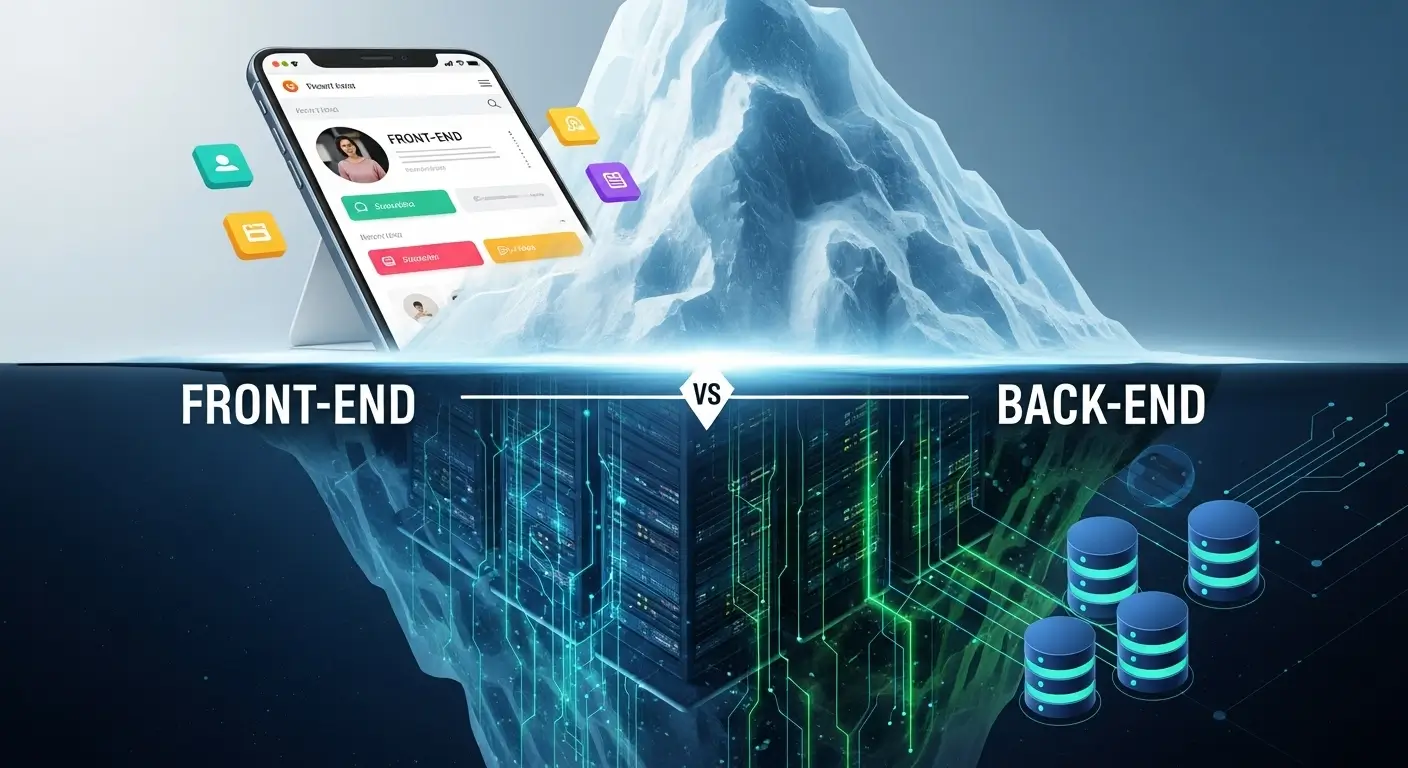In the vast and intricate world of web development, a successful digital product is rarely the result of a single individual’s effort. Instead, it’s a symphony of specialized talents working in harmony. At the core of almost every web application, from a simple blog to a complex e-commerce platform, you’ll find two fundamental pillars: front-end development and back-end development.
Understanding the distinct yet interconnected roles of a Front-End Developer and a Back-End Developer is crucial, whether you’re a project manager assembling a team, an aspiring developer charting your career path, or a business owner looking to partner with a web development company to launch a new digital venture. While both are indispensable to creating a functional and engaging user experience, they operate on vastly different sides of the technological spectrum.
This article will delve deep into the responsibilities, required skill sets, and typical technologies used by each role. We’ll explore how they collaborate, when a full-stack developer might fit the bill, and most importantly, how to determine the right balance of these specialists for your unique project’s success.
The Front-End Developer: The Architect of User Experience
Imagine visiting a website. Everything you see, interact with, and experience – the colors, layouts, buttons, menus, images, and text – is the handiwork of a Front-End Developer. Often referred to as “client-side” developers, their primary focus is on the User Interface (UI) and User Experience (UX). They are the bridge between the raw data and the human user, ensuring that the digital product is not only functional but also visually appealing, intuitive, and enjoyable to use.
Think of a front-end developer as the interior designer and architect for the visible parts of a house. They ensure the house looks good, is easy to navigate, and provides a comfortable living experience for its occupants.
Key Responsibilities of a Front-End Developer:
- Translating Design into Code: Taking static design mockups (from UX/UI designers) and bringing them to life using code.
- Building Responsive and Adaptive Interfaces: Ensuring the website or application looks and functions flawlessly across various devices and screen sizes (desktops, tablets, mobile phones).
- Creating Interactive Elements: Implementing animations, transitions, forms, sliders, and other dynamic features that enhance user engagement.
- Optimizing for Performance: Ensuring fast loading times and smooth user interactions, as slow sites can lead to high bounce rates.
- Ensuring Accessibility: Making the application usable for individuals with disabilities, adhering to web accessibility standards (WCAG).
- Debugging and Troubleshooting: Identifying and fixing issues that arise on the client-side, such as display errors or broken functionalities.
Core Technologies and Skills:
- HTML (HyperText Markup Language): The standard markup language for creating web pages and defining their structure.
- CSS (Cascading Style Sheets): Used for styling the appearance of web pages, including colors, fonts, layout, and responsiveness.
- JavaScript (JS): The programming language that enables interactive elements, dynamic content, and complex web applications.
- JavaScript Frameworks/Libraries:
- React.js: A popular library for building user interfaces, particularly single-page applications.
- Angular: A comprehensive framework for developing large-scale enterprise applications.
- Vue.js: A progressive framework known for its simplicity and flexibility.
- CSS Preprocessors: (e.g., Sass, LESS) for more efficient and organized CSS writing.
- Version Control Systems: (e.g., Git) for collaborative code management.
- Understanding of UI/UX Principles: While not designers, front-end developers must have a strong grasp of design principles to effectively implement them.
The Back-End Developer: The Engine Behind the Scenes
If the front-end is the house’s visible structure and interior, the Back-End Developer is responsible for everything that makes the house functional: the foundation, plumbing, electrical wiring, and utility connections. Often referred to as “server-side” developers, they build and maintain the core logic, databases, and APIs that power the front-end. Their work is invisible to the end-user but is absolutely critical for the application’s stability, security, scalability, and performance.
Back-end developers focus on how data is stored, processed, and exchanged, ensuring that the application runs smoothly, handles user requests efficiently, and remains secure from threats.
Key Responsibilities of a Back-End Developer:
- Database Management: Designing, creating, and maintaining databases (e.g., MySQL, PostgreSQL, MongoDB) to store and retrieve data efficiently.
- Server-Side Logic Development: Building the core application logic that processes user requests, performs calculations, and interacts with databases.
- API (Application Programming Interface) Development: Creating robust APIs that allow the front-end (or other applications) to communicate with the back-end services and databases.
- Security Implementation: Ensuring data integrity, user authentication, authorization, and protection against cyber threats.
- Server Management: Configuring and maintaining servers (e.g., Apache, Nginx) where the application resides.
- Scalability and Performance: Optimizing the application to handle increasing user loads and data volumes without sacrificing speed or reliability.
- System Integrations: Connecting the application with third-party services like payment gateways, email services, or external APIs.
Core Technologies and Skills:
- Programming Languages:
- Python: Popular for its versatility, used with frameworks like Django and Flask.
- Node.js (JavaScript Runtime): Allows JavaScript to be used on the server-side, often with the Express.js framework.
- PHP: A widely used language for web development, especially with the Laravel framework.
- Ruby: Known for its simplicity and productivity, often used with the Ruby on Rails framework.
- Java: A robust language for large-scale enterprise applications, often with the Spring framework.
- Databases:
- Relational (SQL): MySQL, PostgreSQL, Oracle, SQL Server.
- Non-relational (NoSQL): MongoDB, Cassandra, Redis.
- APIs: RESTful APIs, GraphQL.
- Cloud Platforms: AWS, Google Cloud Platform (GCP), Microsoft Azure.
- Version Control Systems: (e.g., Git) for collaborative code management.
- Understanding of Server Architecture: Knowledge of how servers, networks, and operating systems interact.
How Front-End and Back-End Collaborate
While distinct, the front-end and back-end are two halves of a whole, constantly interacting to deliver a seamless user experience. Their connection is primarily facilitated by APIs (Application Programming Interfaces).
Think of an API as a waiter in a restaurant. When you (the front-end) want to order food (request data), you don’t go into the kitchen (the back-end) yourself. Instead, you tell the waiter (the API) your order. The waiter then goes to the kitchen, gets your food, and brings it back to you. Similarly, when a user clicks a button on a website, the front-end sends a request to the back-end via an API. The back-end processes this request, interacts with the database if necessary, and sends back the required data to the front-end, which then displays it to the user.
Effective collaboration between front-end and back-end teams is paramount. This requires:
- Clear Communication: Regular discussions to define API specifications, data structures, and functionality requirements.
- Shared Understanding: Both teams should have a basic understanding of the other’s domain to anticipate challenges and propose solutions.
- Version Control: Using systems like Git ensures smooth integration of code changes from both sides.
Without the back-end, the front-end would be a beautiful but static display with no real functionality or data storage. Without the front-end, the powerful back-end would be an inaccessible engine with no way for users to interact with it.
When One Isn’t Enough: The Rise of the Full-Stack Developer
Sometimes, a developer possesses the skills and knowledge to work on both the front-end and the back-end. These individuals are known as Full-Stack Developers. They are essentially polyglots of the web development world, capable of building a web application from end to end.
Pros of Hiring a Full-Stack Developer:
- Holistic Understanding: They have a complete view of the project, which can lead to more coherent architecture and fewer communication gaps.
- Faster Prototyping: Can quickly build and iterate on features without waiting for another specialist.
- Versatility: Can jump between tasks, helping out wherever needed.
- Reduced Communication Overhead: Fewer people to coordinate.
Cons of Relying Solely on Full-Stack Developers:
- Breadth Over Depth: While knowledgeable across the stack, they might not have the same specialized depth as dedicated front-end or back-end experts in complex areas.
- Workload: A single full-stack developer tackling a large, complex project can quickly become overwhelmed.
- Keeping Up with Changes: The web development landscape evolves rapidly; mastering both front and back ends thoroughly is a continuous challenge.
Full-stack developers are often ideal for smaller projects, startups with limited budgets, or when building MVPs (Minimum Viable Products). For larger, more complex, or highly scalable projects, a team of specialized front-end and back-end developers typically offers greater efficiency, expertise, and long-term maintainability.
Deciding What Your Project Needs: Front-End vs. Back-End Focus
Determining the ideal balance of front-end and back-end expertise for your project hinges on its specific nature, goals, and complexity.
Consider the following questions:
- Is your project highly visual and interactive?
- Examples: A complex single-page application, an interactive data visualization dashboard, a sophisticated e-commerce site with extensive product filtering, or a social media platform.
- Emphasis: You’ll likely need a stronger front-end team to craft a stellar user experience, optimize performance, and handle intricate UI components.
- Does your project involve complex business logic, large amounts of data, or robust security requirements?
- Examples: A financial trading platform, a healthcare system managing sensitive patient data, an internal enterprise resource planning (ERP) system, or an application with extensive third-party integrations.
- Emphasis: A robust back-end team will be critical for designing efficient databases, building secure APIs, ensuring data integrity, and scaling the system.
- Is performance and scalability a critical concern?
- Both front-end and back-end contribute to performance.Front-end optimizes loading times and smooth interactions, while back-end ensures fast data retrieval and processing under heavy load. A balanced approach is crucial.
- What is your project’s long-term vision and potential for growth?
- Thinking about future features and potential user growth helps in designing a scalable architecture from day one, which is largely a back-end concern, but also requires a flexible front-end to accommodate new functionalities.
Most modern web applications require a healthy dose of both. A project focused on creating a beautiful, static informational website might lean more heavily on front-end skills. Conversely, a data-processing application with minimal user interface might require a predominantly back-end team. However, for a truly successful, dynamic web application, neither role can truly exist in isolation.
The Synergy for Project Success
In conclusion, understanding the distinct yet complementary roles of Front-End Developers and Back-End Developers is not just about technical jargon; it’s about making informed decisions that directly impact your project’s success.
The front-end developer builds the engaging, intuitive, and accessible experience that users interact with daily. The back-end developer constructs the powerful, secure, and scalable infrastructure that makes that experience possible. Together, they create a cohesive and robust digital product that meets user needs and business objectives.
When planning your next digital venture, remember that a strong, collaborative development team, comprising both front-end and back-end specialists (or skilled full-stack developers where appropriate), is the ultimate recipe for success. By recognizing the unique value each brings, you can strategically allocate resources, foster seamless collaboration, and ultimately deliver a web application that truly stands out.
Ready to build your next groundbreaking digital product but unsure how to assemble the perfect team?
Reach out to us for a personalized consultation! Share your project vision, and let our experts help you understand the optimal blend of front-end and back-end talent needed to bring your ideas to life. What’s the biggest challenge you foresee in your upcoming web development project?



